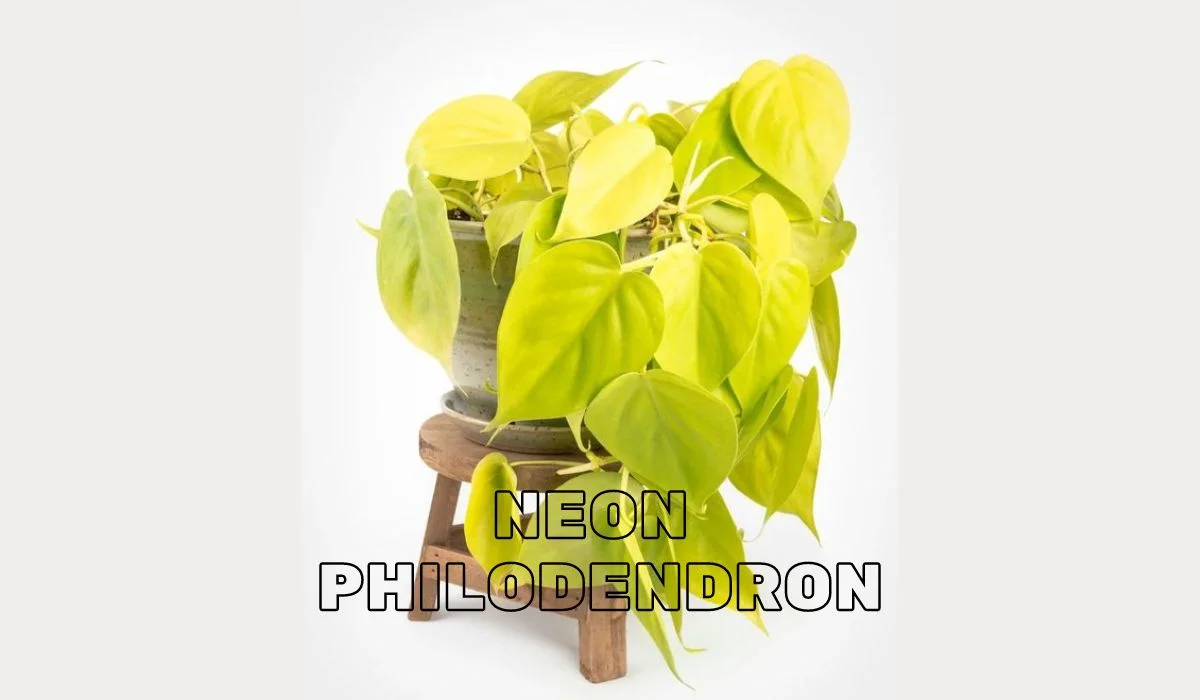The Neon Philodendron is a striking houseplant known for its glowing, golden-lime leaves that can brighten up any room. This plant, often referred to as Philodendron ‘Lemon Lime’ or Philodendron ‘Neon’, is part of the larger philodendron family, which includes various species known for their attractive foliage and easy-care nature. Whether you’re a seasoned plant lover or a beginner, the neon philodendron makes an excellent addition to your home or office, thanks to its ability to thrive in different environments and its visually appealing appearance.
In this comprehensive guide, we will explore everything you need to know about the neon philodendron—from its origins and characteristics to how to care for it in various lighting conditions. We’ll also discuss common issues that may arise and how to propagate the plant to grow your indoor garden.
What is a Neon Philodendron?
The neon philodendron is a variety of the popular philodendron plant, distinguished by its uniquely colored leaves that range from chartreuse to neon yellow. Unlike some other philodendrons that have dark green foliage, the neon variety brings a burst of color to any indoor space. Its heart-shaped leaves are not only eye-catching but also serve as a symbol of its vibrant and healthy growth.
Origins of the Neon Philodendron
Philodendrons are native to the tropical rainforests of Central and South America, where they grow as epiphytes. This means that in their natural habitat, they often climb up trees or sprawl along the forest floor. The neon philodendron is a cultivated variety, developed for its distinctive bright foliage. While it thrives in its native tropical environment, it has adapted well to indoor conditions, making it a popular houseplant worldwide.
Distinctive Features of the Neon Philodendron
- Bright Foliage: The standout feature of the neon philodendron is its glowing yellow-green leaves. These vibrant leaves not only provide a cheerful aesthetic but also symbolize the plant’s health.
- Heart-Shaped Leaves: Similar to other philodendron varieties, the neon variety has smooth, heart-shaped leaves that make it particularly attractive.
- Climbing Growth: Given the right conditions, the neon philodendron can grow as a trailing or climbing plant, allowing you to style it in a variety of ways.
How to Care for a Neon Philodendron
Like other plants in the philodendron family, the neon philodendron is relatively low-maintenance, making it ideal for both novice and experienced plant enthusiasts. However, to help your neon philodendron thrive and grow its vibrant leaves, there are a few care tips to keep in mind.
Light Requirements for Neon Philodendron
One of the key factors that affect the growth and vibrancy of the neon philodendron is the amount of light it receives. While it is more tolerant of low light conditions than some other plants, bright indirect light will enhance the neon glow of its leaves.
- Bright, Indirect Light: For best results, place your neon philodendron near a window that receives bright but filtered light. Avoid direct sunlight, as this can scorch the leaves and cause their color to fade.
- Low Light Conditions: If you live in a space with limited natural light, the neon philodendron can still survive, although its growth may slow down. The leaves may become darker in color, losing some of their bright neon appearance.
Watering and Humidity
When it comes to watering your neon philodendron, consistency is key, but overwatering should be avoided.
- Watering Schedule: Water the plant when the top inch of soil feels dry to the touch. The soil should remain moist but not soggy, as waterlogged soil can lead to root rot. Typically, you should water your plant once a week, adjusting based on your home’s humidity and temperature.
- Humidity Requirements: The neon philodendron thrives in humid environments, mimicking its natural tropical habitat. While it can tolerate average indoor humidity, higher humidity levels will promote more vibrant growth. You can increase humidity by misting the plant occasionally or placing a humidity tray beneath it.
Soil and Potting
The neon philodendron prefers well-draining soil that allows for adequate airflow to the roots. A potting mix formulated for tropical plants or an aroid mix is ideal for this plant.
- Best Soil Type: Use a light, well-draining soil mix that includes peat moss, perlite, and bark. This will ensure that water drains easily and prevents the roots from sitting in water.
- Repotting: This is a relatively fast grower, so repotting may be necessary every one to two years, depending on the size of the plant. Look for signs such as roots growing out of the pot’s drainage holes, which indicate that the plant needs more space.
You Might Also Like: Fibra : Pioneering Sustainable Fibre Crops for a Greener Future
Fertilizing the Neon Philodendron
To encourage healthy growth and vibrant foliage, fertilize it every four to six weeks during the growing season (spring and summer). Use a balanced, water-soluble fertilizer at half strength to avoid over-fertilizing, which can lead to salt build-up in the soil.
Pruning and Maintenance
It doesn’t require extensive pruning, but occasional trimming can help keep the plant looking tidy and promote fuller growth.
- How to Prune: Trim back any leggy or damaged stems to encourage bushier growth. Use clean, sharp scissors or pruning shears to make clean cuts just above a leaf node.
- Cleaning the Leaves: Dust can accumulate on the large leaves, hindering the plant’s ability to photosynthesize. Wipe the leaves with a damp cloth to keep them clean and healthy.
Common Issues with Neon Philodendron
Although it is relatively easy to care for, there are a few common issues that can arise.
Yellowing Leaves
Yellowing leaves on your neon philodendron could be a sign of overwatering. Check the soil’s moisture level and adjust your watering schedule accordingly. Yellowing can also occur due to poor drainage or low light conditions.
Drooping Leaves
Drooping leaves may indicate that the plant is either underwatered or overwatered. Check the soil moisture and adjust your watering routine. If the soil is dry, give the plant a thorough watering. If it’s soggy, allow the soil to dry out before watering again.
Pest Problems
Like many houseplants, this can occasionally attract pests such as spider mites, aphids, and mealybugs. Regularly inspect the leaves for any signs of infestation, such as webbing or sticky residue. If you spot pests, treat the plant with insecticidal soap or neem oil.
How to Propagate a Neon Philodendron
One of the joys of owning it is the ease with which it can be propagated, allowing you to grow new plants from a single specimen.
Steps for Propagating Neon Philodendron in Water
- Select a Healthy Stem: Choose a healthy stem with at least one leaf and one node. The node is where new roots will grow.
- Cut the Stem: Using clean scissors, cut just below the node. Remove any leaves that would be submerged in water.
- Place in Water: Place the cutting in a glass of water, ensuring that the node is submerged.
- Wait for Roots to Grow: After a few weeks, roots should begin to form. Once the roots are at least an inch long, you can transfer the cutting to soil.
Steps for Propagating Neon Philodendron in Soil
- Prepare the Cutting: Follow the same steps to cut a stem with a node.
- Plant in Soil: Instead of placing the cutting in water, plant it directly in a small pot filled with moist, well-draining soil.
- Provide Humidity: Keep the soil moist and place the pot in a warm, humid environment. Covering the pot with a plastic bag can help maintain humidity.
- Monitor for Growth: After a few weeks, the cutting should begin to take root and grow new leaves.
Styling and Displaying Your Neon Philodendron
This is a versatile plant that can be styled in various ways to suit your home’s décor. Its trailing vines make it ideal for hanging baskets or placing on shelves, allowing the vibrant leaves to cascade down. Alternatively, you can train the plant to climb a trellis or moss pole for a vertical display.
Conclusion
The neon philodendron is a vibrant, easy-care plant that adds a pop of color to any indoor space. Its bright neon leaves stand out in low light conditions, and it adapts well to different environments, making it a perfect choice for both beginners and seasoned plant lovers. By following the care tips outlined in this guide, you can ensure that your thrives, bringing beauty and joy to your home for years to come.
Whether you’re looking to brighten up a dull corner of your home or add to your collection of indoor plants, this is a versatile and rewarding plant that will not disappoint.




